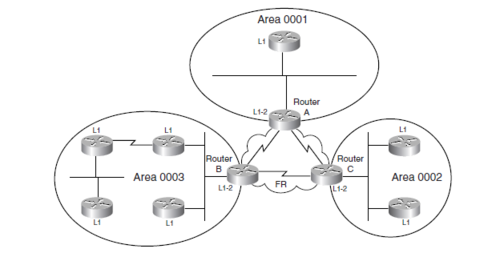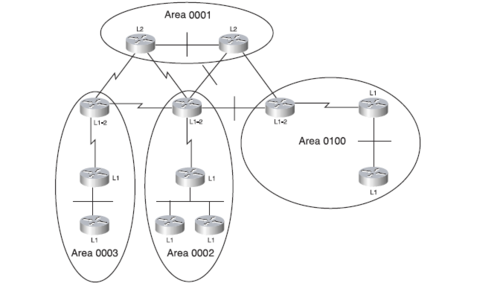IS-IS
For IS-IS to IPv6 see IS-IS IPv6
Intermediate-System to Intermediate-System
IS-IS is a link state Routing protocol which are also used in IP network. Here it is called integrated IS-IS. IS-IS is often used by providers as an IGP.
Level 1 Routing
A level 1 Router only knows about the area in which it is located. Like a stub Router in OSPF. It has no knowledge of other areas. A level 1 Router only knows a default Route to the nearest level 2 Router if Routing between areas is necessary. Every Level 1 Router in that area has the same link State Database containing information about that area.
Level 1 Routers are referred to as Intra-area Routers
Level 2 Routing
A Level 2 Router routes between areas and are referred to as Backbone Routers. The backbone must be contiguous because all Level 2 Routers share the same Link-State Database which contain prefixes from all areas. If the backbone is fractured Routing information will not be the same on all Level 2 Routers.
Level 2 Routers are referred to as Inter-area Routers
Level 1-2 Routers
The Level 1-2 Router has both the Level 1 Link-state database containing information about the area in which it participates and Level 2 Link-state database containing information about all areas.
Point-to-point link Adjacencies
If a Point-to-Point link connects two Routers the Routers are neighbors and each side send a CSNP - Complete Sequence Number Packet - which is a packets containing the Link State database to each other.
Broadcast links Adjacencies
On broadcast link medias, for example Ethernet, all Routers receive receive LSP - link State packets - from one router the DIS - Designated Intermediate system. The DIS Router has the responsibility to flood LSP's to all connected IS-IS Routers on behalf of the pseudonode.
Pseudonode
The pseudonode is a virtual Router that represents the LAN. All IS-IS Routers participating on the LAN simulate an interface on the imaginary Router. This imaginary Router is called the pseudonode. The pseudonode floods LSP's to all participating Routers. In the real world it is the DIS who sends LSP packets. The DIS is elected from the priority on the interface which defaults to 64. If all priorities are the same the DIS is elected as having the highest SNPA (Data-link address)
Configuration
Example
interface Loopback0
ip address 192.168.100.12 255.255.255.255
ip router isis
!
interface fastethernet 0/0
ip address 83.90.2.3 255.255.255.0
ip router isis
!
router isis
net 49.0000.1921.6810.0012.00
is-type level-2-only
metric-style wideISIS and default-information
ISIS level 2 default announce 0.0.0.0 regardless of the network appears in the Routing table. To avoid this use a Route-map
interface FastEthernet0/1
description internet access
ip address dhcp
ip nat outside
!
router isis
mpls traffic-eng router-id Loopback0
mpls traffic-eng level-2
net 49.0000.0101.3300.3333.00
is-type level-2-only
metric-style wide
default-information originate route-map Internet
!
access-list 10 permit any
!
route-map Internet permit 10
match ip address 10How Route Summarization Can Enhance Scalability in IS-IS Networks
Summarization is a key factor that affects the scalability of a routing protocol. Summarization reduces the number of routing updates that are flooded across areas or routing domains. Especially for multi-area IS-IS, a good addressing scheme can optimize summarization by not allowing an overly large Level 2 database that is unnecessarily populated with updates that have come from Level 1 areas.
A router can summarize prefixes on redistribution whether the prefixes have come from internal prefixes, local redistribution, or Level 1 router redistribution. Routes that have been leaked from Level 2 to Level 1 and routes that are advertised into Level 2 from Level 1 can also be summarized.
Router(config-router)#<input>summary-address 1.0.0.0 255.0.0.0 ?</input>
level-1 Summarize into level-1 area
level-1-2 Summarize into both area and sub-domain
level-2 Summarize into level-2 sub-domain
<cr>Metrics
The original IS-IS specification defines four different types of metrics. Cost, being the default metric, is supported by all routers. Delay, expense, and error are optional metrics. The delay metric measures transit delay, the expense metric measures the monetary cost of link utilization, and the error metric measures the residual error probability associated with a link.
The Cisco implementation uses cost only. If the optional metrics were implemented, there would be a link-state database for each metric and SPF would be run for each link-state database.
Default Metric
While some routing protocols calculate the link metric automatically based on bandwidth (OSPF) or bandwidth/delay (Enhanced Interior Gateway Routing Protocol EIGRP), there is no automatic calculation for IS-IS. Using old-style metrics, an interface cost is between 1 and 63 (6 bit metric value). All links use the metric of 10 by default. The total cost to a destination is the sum of the costs on all outgoing interfaces along a particular path from the source to the destination, and the least-cost paths are preferred.
The total path metric was limited to 1023 (the sum of all link metrics along a path between the calculating router and any other node or prefix). This small metric value proved insufficient for large networks and provided too little granularity for new features such as Traffic Engineering and other applications, especially with high bandwidth links. Wide metrics are also required if route-leaking is used.
Extended Metric
Cisco IOS Software addresses this issue with the support of a 24-bit metric field, the so-called "wide metric". Using the new metric style, link metrics now have a maximum value of 16777215 (224-1) with a total path metric of 4261412864 (254 x 224).
Deploying IS-IS in the IP network with wide metrics is recommended to enable finer granularity and to support future applications such as Traffic Engineering.
Running different metric styles within one network poses one serious problem: Link-state protocols calculate loop-free routes because all routers (within one area) calculate their routing table based on the same link-state database. This principle is violated if some routers look at old-style (narrow), and some at new-style (wider) TLVs. However, if the same interface cost is used for both the old- and new-style metrics, then the SPF will compute a loop-free topology.

